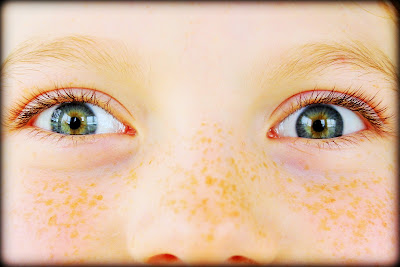Josh and I have a joke that I had nothing to do with the kids, I just carried them. They have his coloring, his height, his looks. I have brown eyes, Josh has ocean eyes. The kids have ocean eyes as well. They have what is called central heterochromia. This occurs in irises with low levels of melanin. The area of iris around their pupils is a golden-brown sunburst, this is the area effected by heterochromia. The outer circle is green, or blue, or gray, depending on the light, the weather, of what they are wearing, this is the true eye color. The color changes like the ocean changes with the weather or season. I love my children's eyes, though I do sometimes long for a brown-eyed baby (it isn't happening).
These are Flynn's. His eyes typically have bluer tones than his sisters'. The sunburst is a dark goldenrod, the powder blue center ring fades into such a deep cobalt blue. Also, I think Flynn is secretly Peter Pan. Just look at that lovely mischief.
These are Poppy's. Hers are almost hazel-looking upon first glance. Her inner sunburst is a raw sienna. The viridian inner ring fades into a dark slate blue. Poppy certainly makes up for the low melanin levels in her eyes with some incredible freckles.
Avalon's are much like Poppy's, though softer and maybe darker, I think, with fewer green tones. Her sunburst is bronze. Light charcoal blue fades into the same slate blue as her sister's. Avalon also has the perfect little dash of mischief in her eyes.
There are other kinds of heterochromia. Complete heterochromia means that both eyes are completely different colors. It is quite rare, though Avalon's Tsuki-cat has one golden-green eye and one blue eye, which can be common among white cats. There is also sectoral heterchromia which causes patches or blocks of different color in the iris.
Heterochromia can be an indication of a disease, injury (David Bowie!!!), or genetic mosaicism, but in the case of my children and husband, it is simply a very cool inherited genetic trait. Like brown eyes, central heterochromia is an autosomal dominant trait, which means that it is expressed even if only one copy is present. If Josh carries two genes for central heterochromia, the theory is that they would have heterochromia regardless of the genes I contribute. I am really not sure how two autosomal dominant eye color traits would battle it out, and I am not sure what the likelihood of me ever having a brown-eyed baby would have been. Apparently, in my children, his eyes won!



L <3 V E
ReplyDeleteMine and my kids' eyes all have the sunburst effect, but I didn't realize it had a name! Thanks for the lesson, and some gorgeous pictures!
ReplyDelete